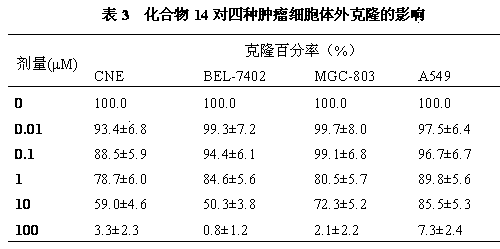Xanthone derivative and preparation method and application thereof
A technology of xanthone and compound, applied in the field of medicinal chemistry, can solve the problems of insufficient activity, complex structure, difficult synthesis and the like
- Summary
- Abstract
- Description
- Claims
- Application Information
AI Technical Summary
Problems solved by technology
Method used
Image
Examples
Embodiment 1
[0031] Example 1: 1,3-dihydroxyxanthone (compound 1 )Synthesis
[0032] Add 2.76 g (20 mmol) of o-hydroxybenzoic acid, 2.52 g (20 mmol) of phloroglucinol and 8 g of freshly prepared molten zinc chloride into 50 mL of phosphorus oxychloride. Pass dry N 2 For 3 to 5 minutes, the water vapor in the reaction bottle should be removed as much as possible, and the 2 Stir in an oil bath at 65-70°C under protection until the raw material disappears as traced by TLC, and stop the reaction for about 1-1.5 hours. The reacted mixture was cooled to room temperature, and poured into 500 mL of ice-water mixture, a large amount of orange-red flocculent solids were precipitated. Cool the diluted solution to room temperature, adjust the pH to 7 with saturated sodium carbonate solution, filter with suction, and wash with water to obtain an orange-red filter cake. The filter cake was dried, separated and purified by silica gel column chromatography, and the eluent was ethyl acetate:petroleum ...
Embodiment 2
[0036] Example 2: 1-hydroxy-3-(2-bromo-ethoxy)-9H-xanthene-9-one (compound 2 )Synthesis
[0037] Add 1.01 g (4.4 mmol) of compound to a 50 mL round bottom flask 1 , dissolved it in 15 mL of anhydrous acetone, and then added 1.2 g (8.8 mmol) of K 2 CO 3 and 6.2 mmol of dibromoethane, heated to reflux in a 58 ?C oil bath with stirring, a yellow solid was gradually formed during the reaction, and the reaction was stopped after 24 hours (TLC traced until the disappearance of the raw material). Add 20 mL of anhydrous acetone to the reaction mixture while hot, suction filter, wash with anhydrous acetone to obtain a yellow filter cake and a yellow filtrate, remove the solvent from the filtrate under reduced pressure to obtain a yellow powder solid, and recrystallize the solid powder with acetone to obtain a yellow flake Crystals with a yield of 51%.
[0038] m.p.: 184~186?C; 1H NMR (CDCl 3 , 500 MHz), δ: 8.18 ( dd , J =1.5, 9.4 Hz, 1H), 7.90 ( td , J =1.6, 8.6 Hz, 1H), 7....
Embodiment 3
[0041] Example 3: 1-hydroxyl-3-(3-bromo-propoxy)-9H-xanthene-9-ketone (compound 3 )Synthesis
[0042] 1.01 g (4.4 mmol) compound 1 And 6.2 mmol 1,3-dibromopropane, according to the synthetic method of embodiment 2, obtain compound 3 , yield 58%.
[0043] m.p.: 119~121?C; 1 H NMR (CDCl 3 , 500 MHz), δ: 12.87 ( s , 1H), 8.28 ( dd , J =1.2, 7.9 Hz, 1H), 7.75 ( td , J =1.4, 8.5 Hz, 1H), 7.46 ( d , J= 8.3 Hz, 1H), 7.40 ( t , J =7.4 Hz, 1H), 6.47 ( d , J =2.1 Hz, 1H), 6.34 ( d , J =2.1 Hz, 1H), 4.19~4.38 ( m , 2H), 3.55~3.68 ( m , 2H), 2.33~2.38 ( m , 2H); 13 C NMR (CDCl 3 , 125 MHz) δ:180.8, 165.8, 163.6, 157.8, 156.1, 135.0, 125.9, 124.0, 120.6, 117.5, 104.1, 97.5, 93.2, 66.0, 31.9, 29.6; IR (KBr41) 5, ν 1 1573, 1466, 1441, 1299, 1225, 1158, 1038, 825, 669 cm –1; APCI-MS: 269 [M+H] + ; Anal. Calcd for C 16 h 13 BrO 4 : C, 55.04; H, 3.75. Found: C, 55.07; H, 3.71.
[0044] compound 3 The structural formula is as follows:
[0045]
PUM
 Login to View More
Login to View More Abstract
Description
Claims
Application Information
 Login to View More
Login to View More - R&D Engineer
- R&D Manager
- IP Professional
- Industry Leading Data Capabilities
- Powerful AI technology
- Patent DNA Extraction
Browse by: Latest US Patents, China's latest patents, Technical Efficacy Thesaurus, Application Domain, Technology Topic, Popular Technical Reports.
© 2024 PatSnap. All rights reserved.Legal|Privacy policy|Modern Slavery Act Transparency Statement|Sitemap|About US| Contact US: help@patsnap.com










